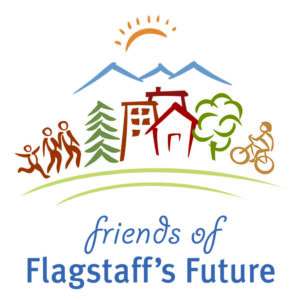Published March 9, 2021 3/9/2021. Arizona Daily Sun
A recent editorial, published March 4, 2021, unfortunately confounded the relationship between the City’s efforts to address affordable housing and its Climate Action and Adaptation Plan (CAAP). Friends of Flagstaff’s Future supports both of these efforts. Affordable housing and the goals of reducing carbon emissions and adapting to climate change as outlined in Flagstaff’s CAAP are mutually compatible with each other. This is clearly a case where two important community goals can be solved by thoughtfully designed policies.
Simply increasing the supply of homes alone, in the same manner in which we have over the last 20 years, will not solve Flagstaff’s home affordability crisis. There is no evidence that building more housing units automatically means more affordable housing. Flagstaff has seen tremendous growth in second homes, a purchase that requires an income equal to 2.6 times larger than the income of a person buying a primary home, according to national statistics.
Addressing the demand for affordable housing is made difficult due to state preemptive laws and the fact that median to higher end homes are more profitable to build. We need to work for changes at the state level that allow communities to work creatively with developers to build a stock of housing that is affordable for our workforce.
While we work for statewide changes, we can also support the City’s proposals for Neighborhood Community Commercial (NCC) zoning and appropriate in-fill projects.The NCC zoning is one example of increasing the density of housing units in identified specific areas while preserving neighborhoods. This zoning proposes to limit the heights of some buildings to 45 feet (four stories) rather than 60 feet (six stories) in these identified areas of the city where zoning “activity centers” overlap with established neighborhoods. This is a reasonable proposal that avoids the kind of controversy that arose when the Hub was built in a downtown neighborhood. If additional housing units in these NCC areas can be built with a focus on affordability, they will not result in a conflict between density and affordability. Further, if these units are built using energy efficient building methods, they will not result in a conflict between the CAAP and affordability.
Affordable housing and the goals of reducing carbon emissions and adapting to climate change as outlined in Flagstaff’s CAAP are mutually compatible with each other. The CAAP pushes Flagstaff to adapt to climate change by implementing a broad array of actions that reduce our carbon footprint and reliability on fossil fuels. Climate change is known to disproportionately impact communities of color and low-income neighborhoods and our ability to adapt now will help reduce some of those impacts. Simply reducing the cost of heating through increased energy efficiency, as outlined in the CAAP, results in ongoing savings.
Flagstaff can grow, be resilient to climate change, meet affordable housing challenges, and maintain our beloved city character. Sometimes this will mean taller buildings in specific areas. We believe affordable housing and adaptation to climate change are compatible. We hope that the community will recognize the need to prioritize these issues and address them together in a way that preserves the character of our community.
Michele James is Executive Director of Friends of Flagstaff’s Future. She is a member of the informal working group exploring the connection between affordable housing and sustainability, convened by the Housing Commission to develop Flagstaff’s 2021-2031 Housing Plan in response to the affordable housing emergency declaration.

